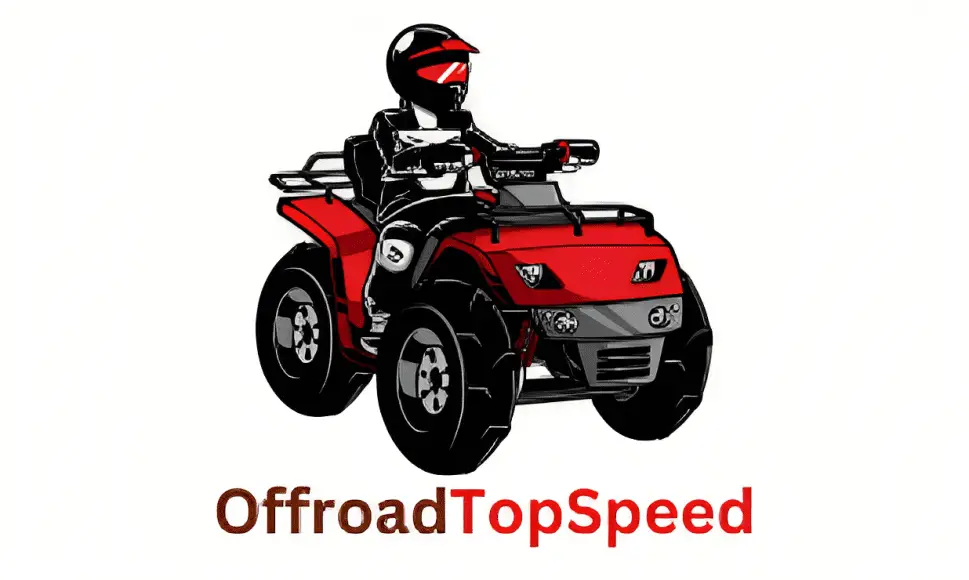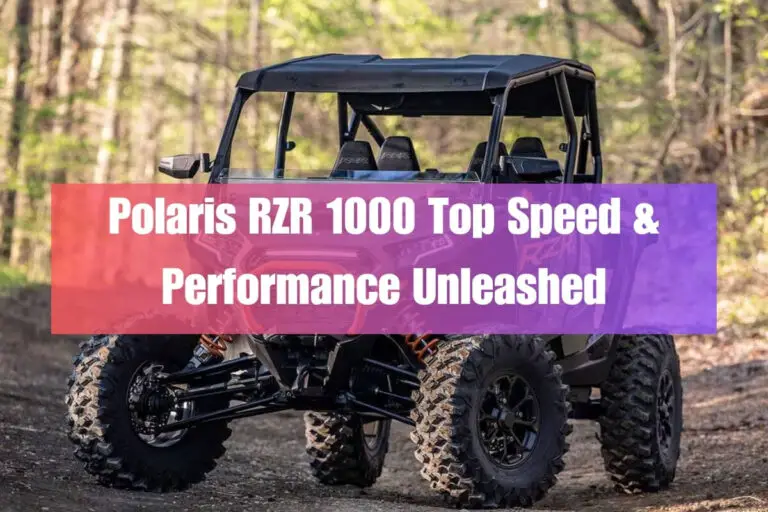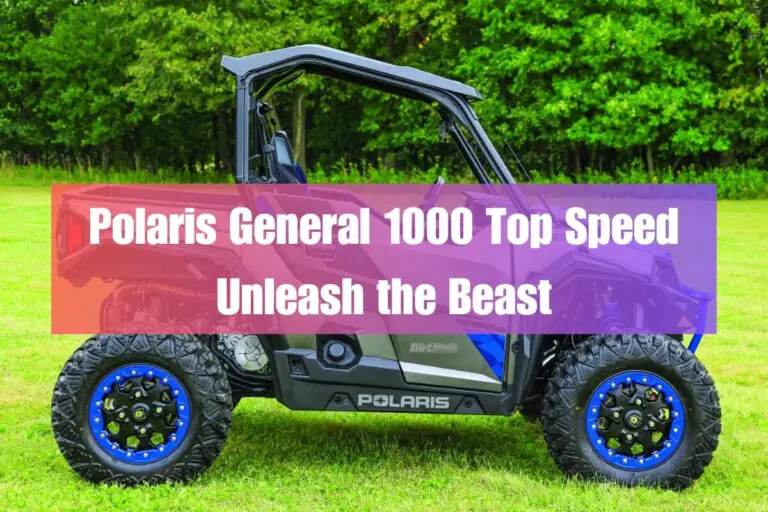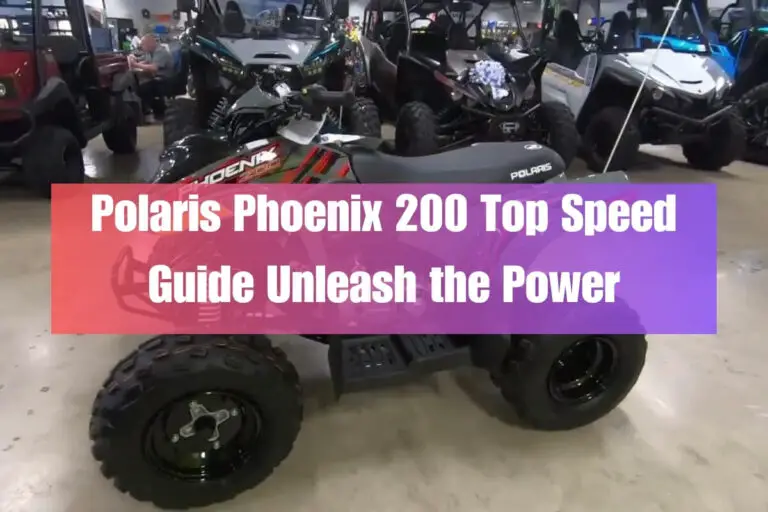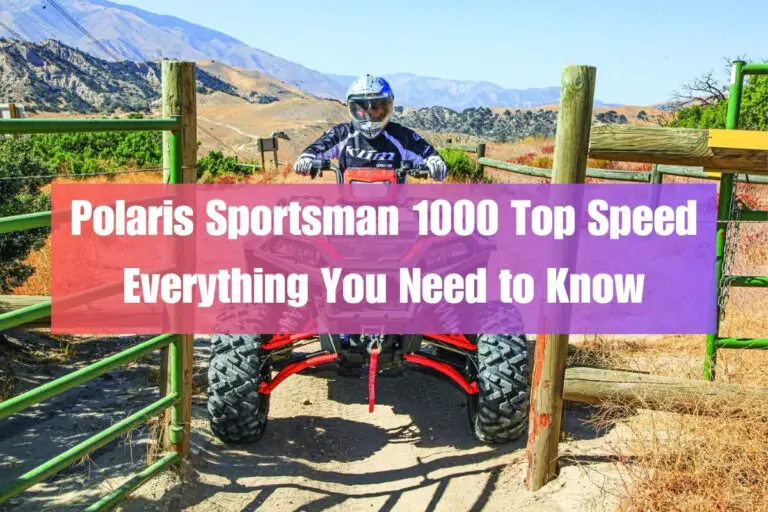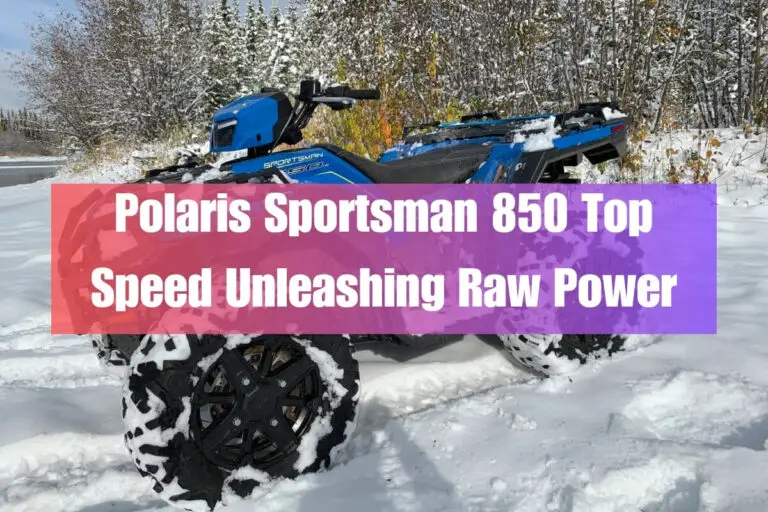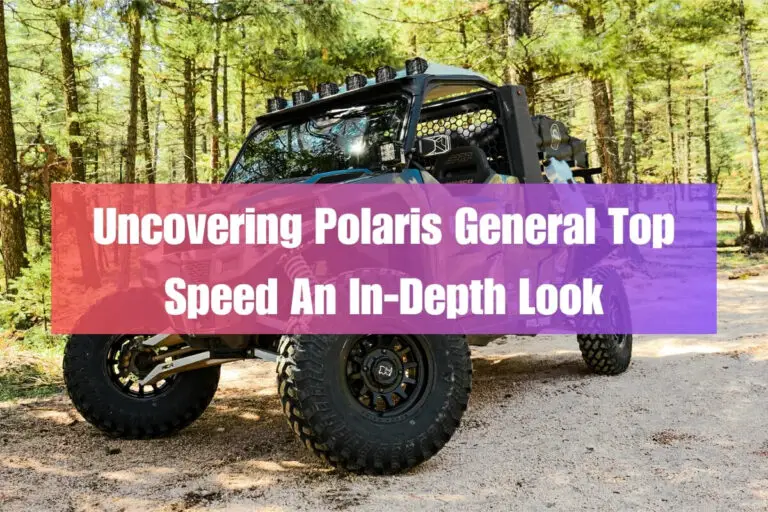Polaris Ranger Top Speed: How Fast Can These UTVs Go?
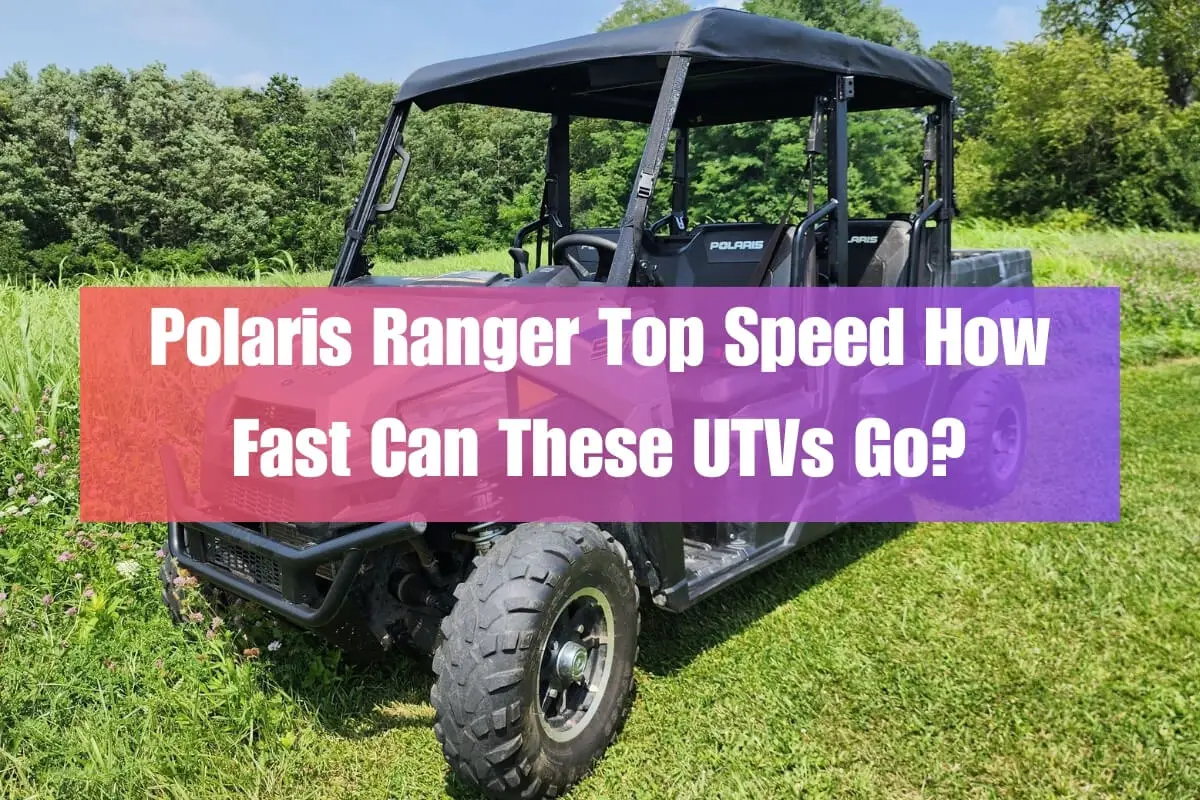
If you’re looking for a powerful and versatile utility vehicle, the Polaris Ranger is likely on your radar. These sturdy side-by-sides are designed to handle tough jobs and trail riding with ease. But one question often comes up – how fast can a Polaris Ranger actually go?
A Polaris Ranger’s top speed depends on the specific model, but most can reach between 45-70 mph on ideal surfaces like pavement or hard-packed dirt. The fastest Rangers are from the large-displacement 1000cc models which can potentially hit 70+ mph with performance mods. Smaller models like the Ranger 570 typically max out around 50 mph stock.
In this post, we’ll dive deep into the top speeds of all the major Polaris Ranger models and trim levels. We’ll also look at factors affecting speed, how to get more mph through mods, how the Rangers stack up against rivals from Can-Am, Honda and others – and who these UTVs are best suited for based on your need for speed.
Polaris Ranger Model Overview
Before we get into the juicy speed numbers, let’s quickly go over the different Polaris Ranger models and their key specs:
Ranger 1000 Series – The flagship Ranger line includes the base Ranger 1000, premium Ranger XP 1000, and crew/6-seater versions. All use a 999cc twin-cylinder engine making 61hp.
Ranger 900 Series – Slightly lower-powered than the 1000s but still punchy, the 900 series includes 2-seat and crew models. The 900 XP makes 68hp from its 854cc twin.
Ranger 800 Series – An older, discontinued line that ran until 2015. The 800 models used a 760cc twin making 50hp.
Ranger 570 Mid-Size – The “little brother” Ranger is an affordable, compact option powered by a 567cc single-cylinder engine with 44hp. Great for tight trails but lower top-end.
Ranger EV Electric – For green operation with zero emissions, Polaris offers several electric Rangers using a 30hp AC motor.
Ranger Crew Models – Many Rangers come in “crew” variants with two rows of seats for 4-6 riders total. The biggest is the 6-person Ranger Crew XP 1000.
In terms of pricing, the current 2023 Polaris Ranger lineup starts around $12,000 for basic models and ranges up to $25,000+ for a fully-loaded Ranger XP 1000 crew with all the bells and whistles.
Factors Affecting Polaris Ranger Top Speed
There are several key variables that determine just how fast a particular Polaris Ranger side-by-side can go:
Engine Size/Power – As a general rule, more engine displacement and horsepower equates to higher top speed potential. The beefy 999cc twins in the Ranger 1000 are the speed kings.
Transmission Type – Most Rangers use a continuously variable transmission (CVT) which is great for easy operation but can slightly limit max speeds compared to a manual gearbox.
Tire Size – Larger diameter tires with more rolling resistance will bleed off some top-end speed compared to smaller stock rubber.
Vehicle Load – The more cargo and passengers you’re hauling, the slower you’ll ultimately be able to go due to the added weight.
Terrain/Conditions – Polaris publishes top speeds for ideal conditions – any mud, hills or loose surfaces will drastically cut into those numbers. Wind and drag are factors too.
Speed Limiters – For safety, most Rangers have a speed limiter that can be removed or adjusted for higher velocities. More on that later!
Top Speeds of Popular Polaris Ranger Models
Now the part you’ve been waiting for – exactly how fast can different Polaris Ranger models actually go from the factory?
Here’s a table with approximate top speed figures for several key Rangers in ideal conditions (pavement/hard pack, no wind, no cargo, etc):
| Model | Engine | Approx Top Speed |
|---|---|---|
| Ranger 1000 | 999cc Twin | 55-60 mph |
| Ranger XP 1000 | 999cc Twin | 55-65 mph |
| Ranger 1000 Crew | 999cc Twin | 60-65 mph |
| Ranger 900 | 854cc Twin | 50-55 mph |
| Ranger 900 XP | 854cc Twin | 55-60 mph |
| Ranger 800 | 760cc Twin | 50 mph |
| Ranger 570 | 567cc Single | 40-50 mph |
| Ranger EV Electric | 30hp AC Motor | 25 mph |
A few key points about Ranger top speeds:
- The Ranger 1000 models are the fastest pavement runners at 55-65mph depending on the tune. Both 2-seat and crew versions are deeply into the “quick” category for UTVs.
- Despite their smaller engines, the Ranger 900 series is still very peppy with 50-60mph top speeds – enough for most trails and chores.
- Older 800cc models and the current entry-level Ranger 570 models are more geared for low/mid-speed operation in the 40-50mph range.
- Electric Rangers top out at just 25mph for low-speed neighborhood use only.
- Terrain and conditions make a massive difference – figure on losing 10+mph for anything other than perfect running surfaces.
Of course, the above speeds are just baselines. There’s a whole world of modifications and tuning that can uncork more performance from these hard-working Polaris machines…
How to Increase Polaris Ranger Top Speed
If you want to push your Ranger beyond Polaris’ factory speed limiters, or simply extract more mph for the trails and dunes, these are some of the most popular modifications:
Performance Air Intakes/Exhausts – Upgrading the intake and exhaust can free up a few extra horses and MPH on its own.
Clutch Kits – From simple clutch re-springs to full helical gear kits, clutch mods can significantly boost acceleration and top-end speed.
ECU Tuning/Remapping – Getting a tuner to remap the engine control software is an easy way to remove factory rev and speed limitations.
Tires/Wheels – Downsizing to lighter, lower-profile tires with less rolling resistance helps acceleration and top speeds.
Performance Pulleys/Gearing – Changing drive pulleys and gearing can shift power delivery for better acceleration or higher trap speeds.
Many owners will stack several of those mods together to get the maximum gains. Expect to spend $500 to $2000+ on parts and labor for significant speed upgrades.
You can also look for used Rangers that have already been built out for speed with those hop-up parts installed. Just watch out for anything too heavily modified – high-mile hi-po Rangers may need considerably more maintenance.
Owner Reviews on Polaris Ranger Top Speeds
To get a real-world perspective on Ranger top speeds, let’s look at a few examples of owner feedback – both positive and negative.
From a glowing review of a 2023 Polaris Ranger 1000:
“The power and acceleration of this thing shocked me, it just keeps pulling all the way to an actual 60mph on the road […] I’m very impressed with how fast it gets up to speed even with a full bed load.”
A satisfied 2021 Ranger 900 XP owner reported:
“Plenty of pep with the 900cc engine, no issues keeping up with friends on larger machines. Does a real-world 55mph on paved roads near home.”
Even the midsize Ranger 570 gets some praise for speed:
“Can’t say enough good things about the 570, the power to weight ratio makes it feel very zippy even if its top speed caps around 50mph on high.”
However, others wish their Rangers had even more outright speed from the factory:
“My only complaint about the Ranger 1000 is Polaris still governs the top speed lower than it should go for the engine size. Fast enough for most stuff but still leaves mph on the table.”
And some simply don’t feel the need for higher top speeds with the Ranger’s intended utility purposes:
“I understand the wish for more power, but putting crazy speed on a machine designed for hauling, towing and off-road work doesn’t make much sense to me. The factory speeds are just fine.”
As you can see, opinions vary based on expectations and how the Ranger is being used. But most owners seem satisfied with the top speeds delivered by these hard-working Polaris side-by-sides.
Polaris Ranger vs Competitors – Top Speed Comparison
Of course, the Polaris Ranger lineup doesn’t exist in a vacuum – it faces stiff competition from other major UTV manufacturers. So how does the Ranger’s straight-line speed stack up against some of the main rivals?
Compared to similar mid-size and full-size utility models, the Ranger generally holds its own for speed:
- Can-Am Defender (Up to 65 mph)
- Honda Pioneer 1000 (Up to 67 mph)
- Kawasaki Mule Pro-FXT (Up to 55 mph)
- John Deere Gator (Up to 53 mph)
The wild card is Can-Am’s Maverick X3 line which includes specialized “X” performance models that can eclipse 80 mph stock from the factory!
But those are more expensive, higher-strung sport UTVs not really intended for the same all-around work/play purposes as the Ranger. For versatile real-world use with adequate speed when needed, the Polaris machines are highly competitive.
Pros and Cons of Polaris Ranger Top Speeds
To summarize the pros and cons of the top speed capabilities of the Polaris Ranger lineup:
Pros
- Broad range of speeds to match different users (25 – 70+ mph)
- Higher speeds adequate for highway/roadwork use on 1000 models
- Easy to modify and upgrade for even more top-end performance
- Strong acceleration and power delivery
- Speed limiters help manage safety for novice users
Cons
- Not the absolute fastest UTVs for pure straight-line speed
- Larger aftermarket investment required for extreme top speeds
- Heavy loads will significantly blunt acceleration and top-end
- Lower speeds can be limiting for open dunes/desert riding
Overall, the Ranger’s top speed abilities represent a well-rounded blend of versatility and performance. There’s enough straight-line muscle for most jobs and adventures, with easy upgrade paths if you need to go flat-out.
Top Alternatives to Polaris Ranger
If you do find that you need higher top speeds than even a modified Ranger can muster, or simply prefer a different brand, here are some of the top alternatives to consider:
Can-Am Maverick X3 Models – The X3 lineup is the king of high speeds, with the X RS Turbo RR Edition reaching a blistering 92 mph!
Arctic Cat Wildcat XX – In the 90-95 mph range, the Wildcat is another wildly fast sport UTV built for desert racing.
Yamaha YXZ1000R SS – Yamaha’s pure sport side-by-side tops out at an impressive 80 mph.
Of course, those are all specialized high-speed desert models at premium price points. For a more affordable all-around UTV with good top-end performance, the Kawasaki Teryx KRX 1000 is also worth a look with top speeds in the 70+ mph range.
The tradeoff with those ultra-high speed side-by-sides compared to the Ranger is that they sacrifice some practicality and comfort in favor of blistering straight-line pace.
Who Should Buy a Fast Polaris Ranger?
Based on the broad speed ranges available across the Ranger family, here are my recommendations for who should consider these Polaris UTVs:
The Ranger 1000 models with their 60+ mph capabilities are a great option for:
- Landowners who need to range over large properties quickly
- Trail and dune riding where moderate higher speeds are beneficial
- Anyone needing true highway-capable speeds for roadwork
The mid-pack Rangers like the 900s and 570s with 45-55 mph top speeds are ideal for:
- General farm, ranch and outdoor work use where pace matters less
- Tighter trail systems where higher speeds aren’t as useful
- More budget-conscious buyers and new UTV owners
And the lower-speed electric and utility Rangers are a smart pick for:
- Neighborhood cruising with limited speed needs
- Younger Drivers and Novice Operators still learning
- Noise/Emissions-restricted areas like parks and camps
Who Should Avoid High-Speed Rangers?
On the flip side, even the fastest Polaris Rangers may not be the ideal pick for:
- Serious desert racers or duners who want blistering top speeds
- Enclosed cab uses where wind noise could be excessive
- Driving in strictly enforced low-speed areas or neighborhoods
Pay close attention to the speed capabilities and limits you actually need before landing on a particular Ranger model. As with most UTVs, there can be compromises between outright speed and other factors like cargo hauling, pricing, comfort, etc.
Polaris Ranger Speed Issues and Troubleshooting
While generally robust and powerful machines, the Polaris Rangers can still run into some issues that can negatively impact speed and acceleration, including:
Slipping Clutches – High RPM loads and abusive driving can cause premature clutch wear and slippage over time.
Electrical Problems – Software issues, faulty speed sensors, and other electrical faults can cause stumbling, misfiring, and lackluster acceleration.
Mechanical Faults – Bad maintenance allowing engine, transmission, or driveline problems will hurt speed.
Tire Issues – Running over-inflated or excessively worn tires can reduce traction and cause spinning rather than forward acceleration.
For any ongoing speed, hesitation or power complaints – start with the basics like checking fluid levels, air filter condition, battery voltage and throttle/drivetrain free play. Many times it’s a simple maintenance item causing the problems.
If that doesn’t resolve things, reference your manual’s troubleshooting chart which can guide you to the root cause of speed and performance issues. Don’t let issues like these go unchecked, as they can lead to further damage and repair bills.
Frequently Asked Questions
What is the fastest Polaris Ranger Model?
The fastest non-modified Polaris Ranger from the factory is the Ranger XP 1000. It can reach speeds of 55-65 mph in ideal conditions.
Can you increase the top speed of a Ranger?
Yes, there are many aftermarket modifications like clutch kits, ECU tuning and exhaust upgrades that can push Ranger top speeds over 70 mph. However, this does impact long-term reliability.
Are Polaris Rangers street legal?
Many Ranger models like the 1000, 900 and 570 are street legal in most areas when properly equipped with turn signals, license, insurance etc. Lower speed electric models are generally off-road only.
How much do mods to increase top speed cost?
Based on owner reports, typical speed mods like clutching and tuning can cost $500 to $2000+ for most Ranger models depending on parts and labor.
What RPM is top speed for a Ranger 1000?
Peak top speeds for a modified Ranger 1000 are usually achieved around 6500-7000 RPM.
Final Thoughts on Polaris Ranger Top Speeds
As you can see, the top speed capabilities of the Polaris Ranger lineup match their impressive versatility. From brawny high-speed 1000 models to lower-speed electric rigs, there’s a Ranger that can meet almost any speed need or preference.
The key is choosing the right amount of straight-line performance based on your specific wants and uses. Polaris gives you the ability to build a Ranger optimized for blistering pace when needed. Or you can pick more sensible mid-pack speeds if outright velocity isn’t your top priority.
Thanks to the brand’s great aftermarket support, bumping up speeds with bolt-ons is also an easy option. So you can buy a lower trim model to start, then add more speed later as your needs evolve.
Just be sure to operate your Ranger at appropriate and safe speeds for your environment, skill level and local laws. A need for speed is great – but responsibility and control should always take priority in these powerful utility vehicles.
